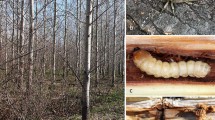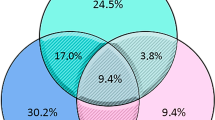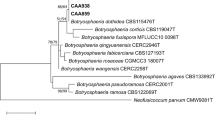Abstract
The occurrence, species diversity and some aspects of taxonomical affinity and host selectivity of acaropathogenic fungi associated with phytophagous, saprotrophic and predacious mites in Poland and other European countries were investigated on wild and cultivated plants, in insect feeding sites under the bark and in decayed wood. From among 33 species of fungi affecting mites only five species of Entomophthorales were separated and the most numerous were Neozygites floridana mostly on Tetranychus urticae, N. abacaridis on a few eriophyid species, and Conidiobolus coronatus attacking gamasid mites most frequently of the genus Dendrolaelaps. The most frequent mite pathogens occurring in mite communities on plants and in wood infested by insects were of the genus Hirsutella. Until now 13 of their form-species have been recognized in these habitats, but only H. kirchneri, H. necatrix and H. thompsonii (including its variety synnematosa) can be treated as exclusive oligophagous pathogens of phytophagous mites, though their potential host range seems to embrace only selected eriophyid or tarsonemid mites. Taxonomical differentiation of fungal strains was based on close morphological observations and molecular analysis of ITS region sequences. Two new species of acaropathogenic fungi were described in these studies. Hirsutella danubiensis sp. nov. was found in the tetranychid T. urticae, whereas H. vandergeesti sp. nov. affected phytoseiid mites of the genera Amblyseius, Neoseiulus, Seiulus and Typhlodromus, and the tarsonemid Tarsonemus lacustris.





Similar content being viewed by others
References
Altschul SF, Thomas LM, Alejandro A et al (1997) Grapped BLAST and PSI-BLAST: a new generation of protein database search programs. Nucleic Acids Res 25:3389–3402
Bałazy S (2000) Zróżnicowanie grup funkcjonalnych grzybów entomopatogenicznych (Diversity of functional groups of entomopathogenic fungi). Biotechnologia 3(50):11–32 (in Polish)
Bałazy S, Wrzosek M, Sosnowska D et al (2008) Laboratory trial to infect insects and nematodes by some acaropathogenic Hirsutella strains (Mycota: Clavicipitaceous anamorphs). J Invertebr Pathol 97:103–113
Boguś MI, Szczepanik M (2000) Histopathology of Conidiobolus coronatus infection in Galleria mellonella larvae. Acta Parasitol 45:48–54
Boguś MI, Szczepanik M, Bałazy S et al (1998) Susceptibility of Galleria mellonella larvae to fungal infection. In: Konopińska D, Goldsworthy G, Nachman RJ, Nawrot J, Orchard I, Rosiński G (eds) Insects: chemical, physiological and environmental aspects. University of Wroclaw, Poland
Chandler D, Davidson G, Pell JK et al (2000) Fungal biocontrol of Acari. Biocontrol Sci Technol 10:357–384
Delalibera I, Hajek AE, Humber RA (2004) Neozygites tanajoae sp. nov., a pathogen of the cassava green mite. Mycologia 96(5):1002–1009
Domsch KH, Gams W, Anderson TH (1980) Compendium of soil fungi. Academic Press, London
Fisher FE (1950) Two new species of Hirsutella Patouillard. Mycologia 42:290–297
Fisher FE (1951) An Entomophthora attacking citrus red mite. Fla Entomol 34:83–88
Hodge KT (1998) Revisionary studies in Hirsutella (Anamorphic Hypocreales: Clavicipitaceae). UMI Microform 9900074, Ann Arbor
Keller S, Petrini O (2005) Keys to the identification of the arthropod pathogenic genera of the families Entomophthoraceae and Neozygitaceae (Zygomycetes), with descriptions of three new subfamilies and a new genus. Sydowia 57(1):23–53
Kumar S, Koichiro T, Masatoshi N (2004) MEGA3: integrated software for molecular evolutionary genetics analysis and sequence alignment. Brief Bioinform 5(2):150–163
Lipa J (1971) Microbial control of mites and ticks. In: Burges HD, Hussey NW (eds) Microbial control of insects and mites. Academic Press, New York
McCoy CW (1996) Pathogens of eriophyoid mites. In: Lindqiust EE, Sabelis MW, Bruin J (eds) Eriophyoid mites—their biology natural enemies and control. Elsevier Science BV, Amsterdam
Miętkiewski R, Bałazy S (2003) Neozygites abacaridis sp. nov. (Entomophthorales), a new pathogen of phytophagous mites (Acari, Eriophyidae). J Invertebr Pathol 83:223–229
Miętkiewski R, Bałazy S, Tkaczuk C (2000) Mycopathogens of mites in Poland—a review. Biocontrol Sci Technol 10:459–465
Miętkiewski R, Bałazy S, Tkaczuk C (2003) Mikozy szpecieli (Acari: Eriophyoidea) występujących na trawach. (Mycoses of eriophyid mites (Acari: Eriophyoidea) occurring on grasses) (in Polish). Progr Plant Protec 43(1):268–276 (in Polish)
Minter DW, Brady BL (1980) Mononematous species of Hirsutella. Trans Br Mycol Soc 74(2):271–282
Minter DW, Brady BL, Hall RA (1983) Five hyphomycetes isolated from eriophyid mites. Trans Br Mycol Soc 81(3):455–474
Ronquist F, Huelsenbeck JP (2003) MRBAYES 3: Bayesian phylogenetic inference under mixed models. Bioinformatics 19:1572–1574
Stensrud O, Hywel-Jones NL, Schumacher T (2005) Towards a phylogenetic classification of Cordyceps: ITS nrDNA sequence data confirm divergent lineages and paraphyly. Mycol Res 109:41–56
Sung GH, Hywel-Jones NL, Sung JM et al (2007) Phylogenetic classification of Cordyceps and the clavicipitaceous fungi. Stud Mycol 57:5–59
Thompson JD, Higgins DG, Gibson TJ (1994) CLUSTAL. In: Improving the sensitivity of progressive multiple sequence alignment through sequence weighting, position specific gap penalties and weight matrix choice. Nucleic Acids Res 22:4673
Tkaczuk C, Miętkiewski R, Bałazy S (2003) Mycoses of phytophagous mites during the winter time. In: 9th European meeting of the IOBC/WPRS working group “Insect pathogens and insect parasitic nematodes” Salzau, Germany, 23–29 May 2003, Abstracts: 108
Van der Geest LPS (1985) Pathogens of spider mites. In: Helle W, Sabelis MW (eds) Spider mites, their biology, natural enemies and control. Elsevier Sci, Amsterdam
Van der Geest LPS, Elliot SL, Breeuwer JAJ, Beerling EAM (2000) Diseases of mites. Exp Appl Acarol 24:497–560
White TJ, Bruns T, Lee S et al (1990) Amplification and direct sequencing of fungal ribosomal RNA genes for phylogenetics. In: McInnnis TM, Gelfand DH, Sninski JJ, White TJ (eds) PCR protocols: a guide to methods and applications. Academic Press, San Diego
Xiang MC, Yang XH, Wang ZX et al (2007) Variability of morphology, parasitism and nucleotide sequences among isolates and species of nematophagous Hirsutella. Biol Control 41(1):110–119
Zare R, Gams W (2001) A revision of Verticillium section Prostrata. IV. The genera Lecanicillium and Simplicillium. Nova Hedwigia 73:1–50
Acknowledgements
The authors wish to express their sincere thanks to Profs. Jan Boczek, Danuta Kropczyńska-Linkiewicz (SGGW-Agricultural University in Warsaw), and Drs. Anna Skoracka, Wojciech Magowski (A. Mickiewicz University in Poznań), and Dariusz Gwiazdowicz (University of Life Sciences in Poznań) for identification of host mites. We are indebted to Romana Lipońska, M.A. and Dr. Teresa Bałazy (A. Mickiewicz University in Poznań) for preparing the Latin diagnoses and the English translation. Our sincere thanks also go to Prof. Marek Tomalak (Institute of Plant Protection in Poznań) and Dr. Damian Józefczyk (Research Centre for Agricultural and Forest Environment in Poznań), for their help and assistance with preparation of figures.
Author information
Authors and Affiliations
Corresponding author
Rights and permissions
About this article
Cite this article
Bałazy, S., Miętkiewski, R., Tkaczuk, C. et al. Diversity of acaropathogenic fungi in Poland and other European countries. Exp Appl Acarol 46, 53–70 (2008). https://doi.org/10.1007/s10493-008-9207-1
Received:
Accepted:
Published:
Issue Date:
DOI: https://doi.org/10.1007/s10493-008-9207-1




